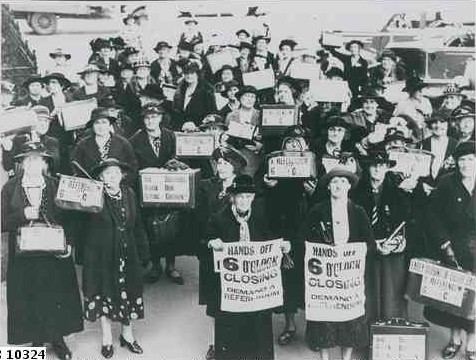 | ||
The six o'clock swill was an Australian and New Zealand slang term for the last-minute rush to buy drinks at a hotel bar before it closed. During a significant part of the 20th century, most Australian and New Zealand hotels shut their public bars at 6 pm. A culture of heavy drinking developed during the time between finishing work at 5 pm and the mandatory closing time only an hour later.
Contents
Introduction of early closing
Six o'clock closing was introduced during the First World War, partly as an attempt to improve public morality and partly as a war austerity measure. Before this reform, most hotels and public houses in Australia had closed at 11 or 11:30 pm. Support for changing hotel closing times originally came from the temperance movement, which hoped that implementing restrictions on the sale of alcohol would lead eventually to its total prohibition. Although the movement had been active since the 1870s, it had been gaining ground since the 1900s following the introduction of 6 o'clock retail trade closing, first legislated in Western Australia in 1897. The argument made by the temperance movement challenged the grounds for public houses being "kept open while bakers' shops were shut". Prominent groups in this movement were the Woman's Christian Temperance Union and the Rechabites. Their agitation was augmented with the outbreak of war in 1914 where it was argued that a "well-ordered, self-disciplined and morally upright home front was a precondition for the successful prosecution of the war."
The first state to introduce early closing was South Australia in March 1916 where the rationale was for supporting the war effort. The law had been approved in the previous year in a referendum held in conjunction with the state election. Six o'clock closing was subsequently adopted in New South Wales, Victoria and Tasmania in the same year. It was introduced in New Zealand in December 1917. Western Australia adopted a 9 pm closing time, but Queensland retained the old closing times until it introduced 8 o'clock closing in 1923.
The question of closing hours was put to New South Wales voters in June 1916. The question had previously been put to the vote in December 1913 when the results of the Local Option Poll were in favour of 11 o'clock closing. The 1916 vote was influenced by a recent riot involving drunken soldiers. In February 1916, troops mutinied against conditions at the Casula Camp. They raided hotels in Liverpool before travelling by train to Sydney, where one soldier was shot dead in a riot at Central Railway station.
Although it was introduced as a temporary measure, it was made permanent in New Zealand in 1918 and in Victoria and South Australia in 1919. The New South Wales government brought in temporary extensions and discussed putting the matter to a referendum. In 1923, however, without testing the matter by a popular vote, the government enacted 6 pm as the closing time.
Hotels catered for a short heavy drinking period after work before the early evening closing by extending their bars and tiling walls for easy cleaning. The phenomenon changed Australian pubs as rooms in the building were converted to bar space; billiard rooms disappeared and bars were knocked together.
The law was intended to reduce drunken mayhem and alcohol consumption but it encouraged them because of the short time men had to consume alcohol between "knock off time" and 6 pm.
Early public house closing times had only limited success; they did not have a significant effect on reducing alcohol consumption and probably contributed to the growth of "sly-grog" venues and the illicit alcohol trade. In many cases, patrons would buy alcohol at bottle shops to consume at home after the six o'clock swill.
The rush to drink
Six o'clock closing often fuelled an hour-long speed-drinking session, as men raced to get as drunk as possible in the limited time available. An unintended consequence was that glasses were saved during the hour after quitting time until the last call came for drinks. Then, the emptied glasses could be refilled. "The bartender didn't carry your glass to the tap. He carried a pistol-shaped spigot hitched to a long tube and squirted your glass full where you stood."
End of early closing hours
Bar closing times were extended to 10 pm in Tasmania in 1937. The issue of ending early closing was put to voters in New South Wales in a referendum in 1947, but it did not achieve the required number of votes to pass. Around the same time, the Supreme Court of New South Wales ruled that private clubs were exempt from alcohol restrictions, allowing them to trade alcohol legally after 6 pm. A second referendum held in 1954 narrowly passed, and closing hours were extended to 10 pm in New South Wales in the following year. Hours were extended in Victoria in 1966, and South Australia was the last state to abolish six o'clock closing with legislation introduced by Don Dunstan in 1967 and the first legal after-six beer being drunk on 28 September.
Bar closing times were extended to 10 pm in New Zealand on 9 October 1967, three weeks after a referendum. An earlier referendum, in 1949, had voted three to one to retain six o'clock closing, but there was partial repeal of the law in 1961, which allowed restaurants to sell liquor until midnight but not hotel bars.
